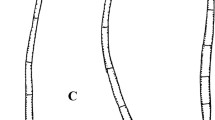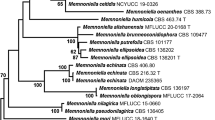Abstract
Two-celled puccinioid teliospores are widely distributed in the rust fungi and appear in several independent lineages of the Pucciniales. About 25 genera in 4 families have been described. Species with two-celled teliospores occurring on members of the Annonaceae are described in the genera Dasyspora, Sphaerophragmium, Diorchidium, Puccinia, and Sphenospora. The molecular and morphological investigations from this study show that Diorchidium polyalthiae, Puccinia popowiae and Sphenospora xylopiae do not belong to the genera in which they were originally assigned. Aecidium deightonii was very closely related to S. xylopiae. Two new genera are erected to accommodate these taxa: (1) Puccorchidium, with the two species P. polyalthiae and P. popowiae; and (2) Sphenorchidium, with the two species S. xylopiae and S. deightonii. They form a well-supported clade in the Pucciniales together with the genus Dasyspora, which also occurs on Annonaceae species, and Puccinia psidii the cause of myrtle rust. The type species of the genus Diorchidium, D. woodii, as well as Sphenospora pallida and S. smilacina appeared within the genus Puccinia. The endocyclic species Endophylloides guineensis occurs on the same host and in the same area as S. xylopiae and S. deightonii, but its relationship could not be determined without DNA data. A key for the rust fungi on Annonaceae with two-celled teliospores is given.







Similar content being viewed by others
References
Aime MC (2006) Toward resolving family-level relationships in rust fungi (Uredinales). Mycoscience 47:112–122
Arthur JC (1926) Uredinales, additions and corrections. In: North American flora, vol 7, part 11:733–796
Beenken L (2014) Pucciniales on Annona (Annonaceae), with special focus on the genus Phakopsora. Mycol Prog 13:791–809. doi:10.1007/s11557-014-0963-5
Beenken L, Berndt R (2010) Rust fungi on Annonaceae: the genus Sphaerophragmium. Mycologia 102(3):650–663
Beenken L, Zoller S, Berndt R (2012) Rust fungi on Annonaceae II: the genus Dasyspora Berk. & M. A. Curtis. Mycologia 104:659–681
Berndt R (1996) Diorchidium taiwanensis sp. nov. (Uredinales) a new Diorchidium from Taiwan. Mycotaxon 59:253–257
Buriticá PC (1991) Familias del orden Uredinales con ciclo de vida completamente reducido. Revta Acad Colomb Cienc Exact Fís Nat 18(69):131–148
Castresana J (2000) Selection of conserved blocks from multiple alignments for their use in phylogenetic analysis. Mol Biol Evol 17:540–552
Cooke C (1882) Exotic fungi. Grevillea 10(56):121–130
Cummins GB (1971) The rust fungi of cereals, grasses and bamboo. Springer, Berlin
Cummins GB, Hiratsuka Y (1983) Illustrated genera of rust fungi, revised edn. APS, St. Paul
Cummins GB, Hiratsuka Y (2003) Illustrated genera of rust fungi, 3rd edn. APS, St. Paul
Doidge EM (1927) [1932] A preliminary study of the South African rust fungi. Bothalia 2:1–228
Edgar RC (2004) MUSCLE: multiple sequence alignment with high accuracy and high throughput. Nucleic Acids Res 32(5):1792–97
Gäumann E (1959) Die Rostpilze Mitteleuropas mit besonderer Berücksichtigung der Schweiz. Beitr. z. Kryptogamenflora d. Schweiz 12. Büchler, Bern
Graça RN, Ross-Davis AL, Klopfenstein NB, Kim M-S, Peever TL, Cannon PG, Aun CP, Mizubuti ESG, Alfenas AC (2013) Rust disease of eucalypts, caused by Puccinia psidii, did not originate via host jump from guava in Brazil. Mol Ecol 22(24):6033–6047
Hawksworth DL (2012) Integrating morphological and molecular data in fungal systematics. In: Misra JK, Tewari JP, Deshmukh SK (eds) Systematics and Evolution of fungi. CRC, Boca Raton, pp 1–14
Hennen JF, Sotão HMP, Winkler Hennen MM (1998) The genus Diorchidium in the Neotropics. Mycologia 90(6):1079–1086
Hennen JF, Figueiredo MB, de Carvalho AA, Hennen PG (2005) Catalogue of the species of plant rust fungi (Uredinales) of Brazil, Jardim Botânico do Rio de Janeiro, Rio de Janeiro: 1–490. http://www.jbrj.gov.br/publica/uredinales/Brazil_Catalogue1drevisado.pdf
Huelsenbeck JP, Ronquist F (2001) MrBayes: Bayesian inference of phylogenetic trees. Bioinformatics 17:754–755
Huson DH, Richter DC, Rausch C, Dezulian T, Franz M, Rupp R (2007) Dendroscope - An interactive viewer for large phylogenetic trees. BMC Bioinf 8:460
Jackson HS (1926) The rusts of South America based on the Holway collections I. Mycologia 18(4):139–162, Plate 18
Kalchbrenner C, Cooke MC (1882) Fungi Macowaniani. Grevillea 11:18–27
Kropp BR, Hansen DR, Wolf PG, Flint KM, Thomson SV (1997) A study on the phylogeny of the dyer’s woad rust fungus and other species of Puccinia from crucifers. Phytopathology 87:565–571
Lohsomboon P, Kakishima OY (1992) A monogroph of Hapalophragmium. Mycol Res 96(6):461–472
Maddison DR, Maddison WP (2003) MacClade 4.0. Sinauer Associates, Sunderland
Magnus P (1891) Beitrag zur Beleuchtung der Gattung Diorchidium. Ber Deutsch Bot Ges 9:187–193, plate 9
Maier W, Wingfield BD, Mennicken NON, Wingfield MJ (2007) Polyphyly and two emerging lineages in the rust genera Puccinia and Uromyces. Mycol Res 111:176–185
McNeill J, Barrie FR, Buck WR, Demoulin V, Greuter W, Hawksworth DL, Herendeen PS, Knapp S, Marhold K, Prado J, Prud’homme Van Reine WF, Smith GF, Wiersema JH, Turland NJ (2012) International Code of Nomenclature for algae, fungi and plants (Melbourne Code) adopted by the Eighteenth International Botanical Congress Melbourne, Australia, July 2011. Koeltz, Regnum Vegetabile 154: i–xxx, 1–208, http://www.iapt-taxon.org/nomen/main.php
Minnis AM, McTaggart AR, Rossman AY, Aime MC (2012) Taxonomy of mayapple rust: the genus Allodus resurrected. Mycologia 104(4):942–950
Pegg GS, Giblin FR, McTaggart AR, Guymer GP, Taylor H, Ireland KB, Shivas RG, Perry S (2014) Puccinia psidii in Queensland, Australia: disease symptoms, distribution and impact. Plant Pathol 63:1005–1021
Pfunder M, Schürch S, Roy BA (2001) Sequence variation and geographic distribution of pseudoflower-forming rust fungi (Uromyces pisi s. lat.) on Euphorbia cyparissias. Mycol Res 105:57–66
Rambaut A, Suchard MA, Xie D, Drummond AJ (2014) Tracer v1.6. Available from http://beast.bio.ed.ac.uk/Tracer
Ritschel A, Berndt R, Oberwinkler F (2007) New observations of rust fungi (Uredinales) from northern Namibia. Mycol Prog 6:137–150
Ronquist F, Huelsenbeck JP (2005) MrBayes. Version 3.1.2. Bayesian analysis of phylogeny. GNU General Public License
Simpson JA, Thomas K, Grgurinovic CA (2006) Uredinales species pathogenic on species of Myrtaceae. Australas Plant Pathol 35:549–562
Stamatakis A (2006) RAxML-VI-HPC: maximum likelihood-based phylogenetic analyses with thousands of taxa and mixed models. Bioinformatics 22(21):2688–2690
Stamatakis A, Hoover P, Rougemont J (2008) A rapid bootstrap algorithm for the RAxML Web servers. Syst Biol 57(5):758–71
Sydow H (1925) Fungi in itinere costaricensis collecti. Ann Mycol 23:308–429
Sydow H, Sydow P (1915) Novae fungorum species. XIII: Ann Mycol 13(1):35–43
Tan M-K, Collins D, Chen Z, Englezou A, Wilkins MR (2014) A brief overview of the size and composition of the myrtle rust genome and its taxonomic status. Mycology 5(2):52–63. doi:10.1080/21501203.2014.919967
Thiers B (2011) [continuously updated]. Index Herbariorum: A global directory of public herbaria and associated staff. New York Botanical Garden’s Virtual Herbarium. http://sweetgum.nybg.org/ih/
van der Merwe MM, Walker J, Ericson L, Burdon JJ (2008) Coevolution with higher taxonomic host groups within the Puccinia/Uromyces rust lineage obscured by host jumps. Mycol Res 112:1387–1408
Viennot-Bourgin G (1958) Trois Urédinales subtropicales nouvelles. Bull Soc Bot Fr 105:500–512
Viennot-Bourgin G (1959) Étude de micromycètes parasites récoltés en Guinée. Ann Inst Nat Agron, Paris 45:1–91
Vilgalys R, Hester M (1990) Rapid genetic identification and mapping of enzymatically amplified ribosomal DNA from several Cryptococcus species. J Bacteriol 172(8):4238–4246
White TJ, Bruns T, Lee S, Taylor J (1990) Amplification and direct sequencing of fungal ribosomal RNA genes for phylogenetics. In: Innis MA, Gelfand DH, Sninsky JJ, White TJ (eds) PCR protocols: a guide to methods and applications. Academic, San Diego, pp 315–322
Yen J-M, Sulmont P (1970) [1969] Les Urédinées du Gabon. II. Un nouveau Sphenospora parasite du Xylopia: Spenospora xylopiae (nov. sp.). Bull Trimest Soc Mycol Fr 85 (3): 351–353
Acknowledgments
The author thanks the curators of B, BPI, K, M, NY, PREM, PC, PUR, S and Z + ZT for loan of specimens. The first author thanks the scientific and technical assistance of the Genetic Diversity Centre of ETH Zurich (GDC), where the molecular part of the study was done. R. Berndt (Zurich) kindly supported the present study funded by the Swiss National Fund (SNF) (project number 135624).
Author information
Authors and Affiliations
Corresponding author
Electronic supplementary material
Below is the link to the electronic supplementary material.
ESM 1
(PDF 136 kb)
Rights and permissions
About this article
Cite this article
Beenken, L., Wood, A.R. Puccorchidium and Sphenorchidium, two new genera of Pucciniales on Annonaceae related to Puccinia psidii and the genus Dasyspora . Mycol Progress 14, 49 (2015). https://doi.org/10.1007/s11557-015-1073-8
Received:
Revised:
Accepted:
Published:
DOI: https://doi.org/10.1007/s11557-015-1073-8




